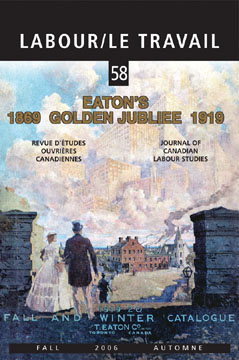Abstract
At the height of World War II labour unrest, Montréal tramway workers, the majority of whom were French Canadian, struck over recognition of their Canadian Congress of Labour-affiliated union over two entrenched rival unions. The strike, which threatened critical wartime production in Canada’s largest industrial centre, illustrates how multi-union workplaces were a source of wartime industrial disorder. Circumstances related to the strike tested the capacity of the federal government to respond in a way which was compatible with Prime Minister King’s broader goals of industrial stability and national unity. King’s inaction on labour law reform at this time led key cabinet ministers to pursue criminal charges against the parties involved in the tramway strike. However, legal proceedings were obverted after King intervened on a recommendation from Carl Goldenberg, who had successfully conciliated the strike. Concurrent to these events was the announcement of a wide-ranging public inquiry into national labour unrest, which eventually led to the adoption of a new labour code (pc 1003). The new federal labour law adopted provisions similar to those in the us Wagner Act, which severely limited union substitution, subjugating worker free choice and collective self-determination to the goals of capital and the state.
Résumé
Au sommet de la mobilisation ouvrière de la Seconde Guerre Mondiale, les travailleurs des tramways à Montréal, qui étaient majoritairement constitués de Canadiens français, déclenchèrent la grève en faveur de la reconnaissance de leur syndicat affilié au Congrès Canadien du Travail. Ils s’opposaient ainsi à deux syndicats existants bien enracinés. La grève, qui mettait en péril une production deguerre névralgique dans le principal centre industriel au Canada, illustre commentles lieux de travail dotés de plusieurs syndicats pouvaient constituer une source de désordre social en temps de guerre. Les circonstances liées à la grève testèrent l’attitude du gouvernement fédéral à réagir d’une manière adéquate aux objectifs destabilité industrielle et d’unité nationale du Premier ministre King. L’inaction de King quant à la réforme de la législation du travail à ce moment mena des ministres importants du cabinet à porter des accusations criminelles à l’endroit des syndicat simpliqués dans la grève. Cependant, les pour suites judiciaires furent abandonnées lorsque King intervint suite à une recommandation de Carl Goldenberg, qui avait réussi à mettre un terme à la grève par la conciliation. Alors que ces événements sedéroulent, le gouvernement fédéral annonce une grande enquête publique sur l’agitation ouvrière à travers le Canada. Celle-ci mènera é ventuellement à l’adoption du nouveau code du travail (PC 1003). Ce nouveau code contenait des dispositions similaires à celles de la loi Wagner aux Etats-Unis, qui limitaient sérieusement les transferts d’allégeance syndicale, asservissant ainsi la liberté de choix des travailleurs et leur autodétermination collective aux objectifs du capital et de l’ État.
